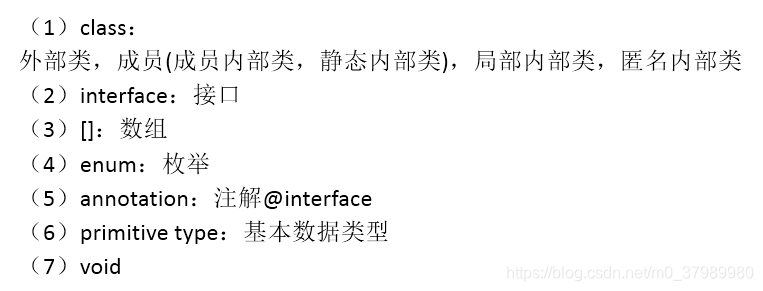一、反射的概述和初体验
- Reflection(反射)是被视为
动态语言的关键,反射机制允许程序在执行期借助于Reflection API取得任何类的内部信息,并能直接操作任意对象的内部属性及方法。
1、体会反射机制的“动态性”
@Test
public void test2(){
for(int i = 0;i < 100;i++){
int num = new Random().nextInt(3);//0,1,2
String classPath = "";
switch(num){
case 0:
classPath = "java.util.Date";
break;
case 1:
classPath = "java.lang.Object";
break;
case 2:
classPath = "com.atguigu.java.Person";
break;
}
try {
Object obj = getInstance(classPath);
System.out.println(obj);
} catch (Exception e) {
e.printStackTrace();
}
}
}
/*
创建一个指定类的对象。
classPath:指定类的全类名
*/
public Object getInstance(String classPath) throws Exception {
Class clazz = Class.forName(classPath);
return clazz.newInstance();
}
2、反射机制能提供的功能

import org.junit.Test;
import java.lang.annotation.ElementType;
import java.lang.reflect.Constructor;
import java.lang.reflect.Field;
import java.lang.reflect.Method;
/**
* @author guizy
* @create 2020 上午 10:38
*/
public class ReflectionTest {
//反射之前,对于Person的操作
@Test
public void test1() {
//1.创建Person类的对象
Person p1 = new Person("Tom", 12);
//2.通过对象,调用其内部的属性、方法
p1.age = 10;
System.out.println(p1.toString());
p1.show();
//在Person类外部,不可以通过Person类的对象调用其内部私有结构。
//比如:name、showNation()以及私有的构造器
}
//反射之后,对于Person的操作
@Test
public void test2() throws Exception{
Class clazz = Person.class;
//1.通过反射,创建Person类的对象
Constructor cons = clazz.getConstructor(String.class,int.class);
Object obj = cons.newInstance("Tom", 12);
Person p = (Person) obj;
System.out.println(p.toString());
//2.通过反射,调用对象指定的属性、方法
//调用属性
Field age = clazz.getDeclaredField("age");
age.set(p,10);
System.out.println(p.toString());
//调用方法
Method show = clazz.getDeclaredMethod("show");
show.invoke(p);
System.out.println("*******************************");
//通过反射,可以调用Person类的私有结构的。比如:私有的构造器、方法、属性
//调用私有的构造器
Constructor cons1 = clazz.getDeclaredConstructor(String.class);
cons1.setAccessible(true);
Person p1 = (Person) cons1.newInstance("Jerry");
System.out.println(p1);
//调用私有的属性
Field name = clazz.getDeclaredField("name");
name.setAccessible(true);
name.set(p1,"HanMeimei");
System.out.println(p1);
//调用私有的方法
Method showNation = clazz.getDeclaredMethod("showNation", String.class);
showNation.setAccessible(true);
String nation = (String) showNation.invoke(p1,"中国");//相当于String nation = p1.showNation("中国")
System.out.println(nation);
}
/*
关于java.lang.Class类的理解
1.类的加载过程:
程序经过javac.exe命令以后,会生成一个或多个字节码文件(.class结尾)。
接着我们使用java.exe命令对某个字节码文件进行解释运行。相当于将某个字节码文件
加载到内存中。此过程就称为类的加载。加载到内存中的类,我们就称为运行时类,此
运行时类,就作为Class的一个实例。
2.换句话说,Class的实例就对应着一个运行时类。
3.加载到内存中的运行时类,会缓存一定的时间。在此时间之内,我们可以通过不同的方式
来获取此运行时类。
*/
//获取Class的实例的方式(前三种方式需要掌握)
@Test
public void test3() throws ClassNotFoundException {
//方式一:调用运行时类的属性:.class
Class clazz1 = Person.class;
System.out.println(clazz1);
//方式二:通过运行时类的对象,调用getClass()
Person p1 = new Person();
Class clazz2 = p1.getClass();
System.out.println(clazz2);
//方式三:调用Class的静态方法:forName(String classPath)
Class clazz3 = Class.forName("com.atguigu.java.Person");
// clazz3 = Class.forName("java.lang.String");
System.out.println(clazz3);
System.out.println(clazz1 == clazz2);
System.out.println(clazz1 == clazz3);
//方式四:使用类的加载器:ClassLoader (了解)
ClassLoader classLoader = ReflectionTest.class.getClassLoader();
Class clazz4 = classLoader.loadClass("com.atguigu.java.Person");
System.out.println(clazz4);
System.out.println(clazz1 == clazz4);
}
//万事万物皆对象?对象.xxx,File,URL,反射,前端、数据库操作
//Class实例可以是哪些结构的说明:
@Test
public void test4(){
Class c1 = Object.class;
Class c2 = Comparable.class;
Class c3 = String[].class;
Class c4 = int[][].class;
Class c5 = ElementType.class;
Class c6 = Override.class;
Class c7 = int.class;
Class c8 = void.class;
Class c9 = Class.class;
int[] a = new int[10];
int[] b = new int[100];
Class c10 = a.getClass();
Class c11 = b.getClass();
// 只要数组的元素类型与维度一样,就是同一个Class
System.out.println(c10 == c11);
}
}
- 疑问1:通过直接new的方式或反射的方式都可以调用公共的结构,开发中到底用那个?
- 建议:直接new的方式。
- 什么时候会使用:反射的方式。 反射的特征:动态性
答:当在编译的时候就可以确定创建哪个对象,此时就可以使用new的方式来创建对象, 如果在编译时不知道创建什么对象,比如说我们后端代码已经跑起来部署到服务器了, 此时前端发送请求来调用后端接口, 此时前端具体要操作什么,创建什么对象, 后端接收到请求后,才回动态的创建这个对象; 此时使用反射就更好,体现了动态性!
- 疑问2:反射机制与面向对象中的封装性是不是矛盾的?如何看待两个技术?
答:不矛盾。比如说单例模式,构造器已经私有化起来了,不建议我们去创建对象,已经提供了一个对外创建对象的公共方法; 可能比我们自己要创建对象的操作要更好,但是如果你非要自己去通过反射来调用私有构造器来创建对象,也是允许的!
二、Class类的理解与获取Class的实例
1、Class类的理解
- 类的加载过程:
程序经过javac.exe命令以后,会生成一个或多个字节码文件(.class结尾)。接着我们使用java.exe命令对某个字节码文件进行解释运行。相当于将某个字节码文件加载到内存中。此过程就称为类的加载。加载到内存中的类,我们就称为运行时类,此运行时类,就作为Class的一个实例。 - 换句话说,Class的实例就对应着一个运行时类。
- 加载到内存中的运行时类,会
缓存一定的时间。在此时间之内,我们可以通过不同的方式来获取此运行时类。
2、获取Class实例的几种方式(前三种方式需要掌握)
//方式一:调用运行时类的属性:.class
Class clazz1 = Person.class;
System.out.println(clazz1);
//方式二:通过运行时类的对象,调用getClass()
Person p1 = new Person();
Class clazz2 = p1.getClass();
System.out.println(clazz2);
//方式三:调用Class的静态方法:forName(String classPath)
Class clazz3 = Class.forName("com.atguigu.java.Person");
// clazz3 = Class.forName("java.lang.String");
System.out.println(clazz3);
System.out.println(clazz1 == clazz2);
System.out.println(clazz1 == clazz3);
//方式四:使用类的加载器:ClassLoader (了解)
ClassLoader classLoader = ReflectionTest.class.getClassLoader();
Class clazz4 = classLoader.loadClass("com.atguigu.java.Person");
System.out.println(clazz4);
System.out.println(clazz1 == clazz4);
3、总结:创建类的对象的方式?
- 方式一:
new+ 构造器 - 方式二:要创建Xxx类的对象,可以考虑:Xxx、Xxxs、XxxFactory、XxxBuilder类中查看是否有静态方法的存在。可以调用其静态方法,创建Xxx对象。
- 方式三:通过反射
4、Class实例可以是哪些结构的说明

三、 使用Classloader加载src目录下的配置文件
1、类的加载过程----了解

2、类的加载器的作用

3、类的加载器的分类

4、Java类编译、运行的执行的流程

5、使用Classloader加载src目录下的配置文件
@Test
public void test2() throws Exception {
Properties pros = new Properties();
//此时的文件默认在当前的module下。
//读取配置文件的方式一:
// FileInputStream fis = new FileInputStream("jdbc.properties");
// FileInputStream fis = new FileInputStream("src\\jdbc1.properties");
// pros.load(fis);
//读取配置文件的方式二:使用ClassLoader
//配置文件默认识别为:当前module的src下
ClassLoader classLoader = ClassLoaderTest.class.getClassLoader();
InputStream is = classLoader.getResourceAsStream("jdbc1.properties");
pros.load(is);
String user = pros.getProperty("user");
String password = pros.getProperty("password");
System.out.println("user = " + user + ",password = " + password);
}
四、创建运行时类的对象
1、代码举例
Class<Person> clazz = Person.class;
Person obj = clazz.newInstance();
System.out.println(obj);
2、说明
newInstance():调用此方法,创建对应的运行时类的对象。内部调用了运行时类的空参的构造器。
要想此方法正常的创建运行时类的对象,要求:
- 运行时类必须提供空参的构造器
- 空参的构造器的访问权限得够。通常,设置为public。
在javabean中要求提供一个public的空参构造器。原因:
- 便于通过反射,创建运行时类的对象
- 便于子类继承此运行时类时,默认调用super()时,保证父类此构造器
五、获取运行时类的完整结构
- 我们可以通过反射,获取对应的运行时类中
所有的属性、方法、构造器、父类、接口、父类的泛型、包、注解、异常等
@Test
public void test1(){
Class clazz = Person.class;
//获取属性结构
//getFields():获取当前运行时类及其父类中声明为public访问权限的属性
Field[] fields = clazz.getFields();
for(Field f : fields){
System.out.println(f);
}
System.out.println();
//getDeclaredFields():获取当前运行时类中声明的所有属性。(不包含父类中声明的属性
Field[] declaredFields = clazz.getDeclaredFields();
for(Field f : declaredFields){
System.out.println(f);
}
}
@Test
public void test1(){
Class clazz = Person.class;
//getMethods():获取当前运行时类及其所父类中声明为public权限的方法
Method[] methods = clazz.getMethods();
for(Method m : methods){
System.out.println(m);
}
System.out.println();
//getDeclaredMethods():获取当前运行时类中声明的所方法。(不包含父类中声明的方法
Method[] declaredMethods = clazz.getDeclaredMethods();
for(Method m : declaredMethods){
System.out.println(m);
}
}
/*
获取构造器结构
*/
@Test
public void test1(){
Class clazz = Person.class;
//getConstructors():获取当前运行时类中声明为public的构造器
Constructor[] constructors = clazz.getConstructors();
for(Constructor c : constructors){
System.out.println(c);
}
System.out.println();
//getDeclaredConstructors():获取当前运行时类中声明的所的构造器
Constructor[] declaredConstructors = clazz.getDeclaredConstructors();
for(Constructor c : declaredConstructors){
System.out.println(c);
}
}
/*
获取运行时类的父类
*/
@Test
public void test2(){
Class clazz = Person.class;
Class superclass = clazz.getSuperclass();
System.out.println(superclass);
}
/*
获取运行时类的带泛型的父类
*/
@Test
public void test3(){
Class clazz = Person.class;
Type genericSuperclass = clazz.getGenericSuperclass();
System.out.println(genericSuperclass);
}
/*
获取运行时类的带泛型的父类的泛型
代码:逻辑性代码 vs 功能性代码
*/
@Test
public void test4(){
Class clazz = Person.class;
Type genericSuperclass = clazz.getGenericSuperclass();
ParameterizedType paramType = (ParameterizedType) genericSuperclass;
//获取泛型类型
Type[] actualTypeArguments = paramType.getActualTypeArguments();
// System.out.println(actualTypeArguments[0].getTypeName());
System.out.println(((Class)actualTypeArguments[0]).getName());
}
/*
获取运行时类实现的接口
*/
@Test
public void test5(){
Class clazz = Person.class;
Class[] interfaces = clazz.getInterfaces();
for(Class c : interfaces){
System.out.println(c);
}
System.out.println();
//获取运行时类的父类实现的接口
Class[] interfaces1 = clazz.getSuperclass().getInterfaces();
for(Class c : interfaces1){
System.out.println(c);
}
}
/*
获取运行时类所在的包
*/
@Test
public void test6(){
Class clazz = Person.class;
Package pack = clazz.getPackage();
System.out.println(pack);
}
/*
获取运行时类声明的注解
*/
@Test
public void test7(){
Class clazz = Person.class;
Annotation[] annotations = clazz.getAnnotations();
for(Annotation annos : annotations){
System.out.println(annos);
}
}
六、调用运行时类的指定结构
调用指定的属性
@Test
public void testField1() throws Exception {
Class clazz = Person.class;
//创建运行时类的对象
Person p = (Person) clazz.newInstance();
//1. getDeclaredField(String fieldName):获取运行时类中指定变量名的属性
Field name = clazz.getDeclaredField("name");
//2.保证当前属性是可访问的
name.setAccessible(true);
//3.获取、设置指定对象的此属性值
name.set(p,"Tom");
System.out.println(name.get(p));
}
调用指定的方法 重点
@Test
public void testMethod() throws Exception {
Class clazz = Person.class;
//创建运行时类的对象
Person p = (Person) clazz.newInstance();
/*
1.获取指定的某个方法
getDeclaredMethod():参数1 :指明获取的方法的名称 参数2:指明获取的方法的形参列表
*/
Method show = clazz.getDeclaredMethod("show", String.class);
//2.保证当前方法是可访问的
show.setAccessible(true);
/*
3. 调用方法的invoke():参数1:方法的调用者 参数2:给方法形参赋值的实参
invoke()的返回值即为对应类中调用的方法的返回值。
*/
Object returnValue = show.invoke(p,"CHN"); //String nation = p.show("CHN");
System.out.println(returnValue);
System.out.println("*************如何调用静态方法*****************");
// private static void showDesc()
Method showDesc = clazz.getDeclaredMethod("showDesc");
showDesc.setAccessible(true);
//如果调用的运行时类中的方法没返回值,则此invoke()返回null
// Object returnVal = showDesc.invoke(null);
Object returnVal = showDesc.invoke(Person.class);
System.out.println(returnVal);//null
}
调用指定的构造器:
@Test
public void testConstructor() throws Exception {
Class clazz = Person.class;
//private Person(String name)
/*
1.获取指定的构造器
getDeclaredConstructor():参数:指明构造器的参数列表
*/
Constructor constructor = clazz.getDeclaredConstructor(String.class);
//2.保证此构造器是可访问的
constructor.setAccessible(true);
//3.调用此构造器创建运行时类的对象
Person per = (Person) constructor.newInstance("Tom");
System.out.println(per);
}